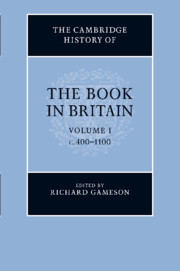Book contents
- Frontmatter
- 1 From Vindolanda to Domesday: the book in Britain from the Romans to the Normans
- PART I THE MAKING OF BOOKS
- PART II THE CIRCULATION OF BOOKS
- 12 Exchanges between the British Isles and the Continent, c. 450 – c. 900
- 13 The circulation of books between England and the Celtic realms
- 14 The circulation of books between England and the Continent, c. 871 – c. 1100
- PART III TYPES OF BOOKS AND THEIR USES
- PART IV COLLECTIONS OF BOOKS
- PART V CODA
- Bibliography
- Concordance of named manuscripts
- Index of manuscripts
- General Index
- Plate 4.1: The Lindisfarne Gospels"
- Plate 5.1: The Lichfield/St Chad Gospels"
14 - The circulation of books between England and the Continent, c. 871 – c. 1100
from PART II - THE CIRCULATION OF BOOKS
Published online by Cambridge University Press: 28 March 2012
- Frontmatter
- 1 From Vindolanda to Domesday: the book in Britain from the Romans to the Normans
- PART I THE MAKING OF BOOKS
- PART II THE CIRCULATION OF BOOKS
- 12 Exchanges between the British Isles and the Continent, c. 450 – c. 900
- 13 The circulation of books between England and the Celtic realms
- 14 The circulation of books between England and the Continent, c. 871 – c. 1100
- PART III TYPES OF BOOKS AND THEIR USES
- PART IV COLLECTIONS OF BOOKS
- PART V CODA
- Bibliography
- Concordance of named manuscripts
- Index of manuscripts
- General Index
- Plate 4.1: The Lindisfarne Gospels"
- Plate 5.1: The Lichfield/St Chad Gospels"
Summary
At some point around 1020, a high-ranking calligrapher–illuminator at Peterborough called Earnwine presented King Cnut and Queen Emma with a fine sacramentary and a psalter; Cnut subsequently sent the two volumes to Cologne as gifts; in 1054 Bishop Ealdred of Worcester tarried in Cologne ‘on the king’s business’, where he was presented with the very same books, which he then brought back to England. We only learn of the adventures of these volumes because they were then entrusted to (St) Wulfstan, a member (possibly prior) of the community of Worcester who, as it happened, had come into contact with them at Peterborough many years before, and their return to his care was thus celebrated as a miracle by his biographer. Other manuscripts can be seen to have made similar round-trips. A compilation of Old Testament, liturgical and computistical texts that was written in northern France in the third quarter of the ninth century had apparently crossed the Channel by the early tenth century when certain letters were retraced by an Anglo-Saxon hand; artwork added by another Anglo-Saxon implies that it was still in England at the end of the tenth century; however, a series of additions by Norman scribes suggests that it migrated to Normandy during the first half of the eleventh century, and its medieval provenance was Jumièges. A collection of tracts and letters by Jerome written in the second half of the ninth century, probably in the Loire region, had passed into Anglo-Saxon hands by the end of the ninth century, as a short colophon in Insular Minuscule at the bottom of the last page of text reveals; prayers added to the originally blank verso show that it was still in England in the earlier tenth century.
Keywords
- Type
- Chapter
- Information
- The Cambridge History of the Book in Britain , pp. 344 - 372Publisher: Cambridge University PressPrint publication year: 2011
- 1
- Cited by

